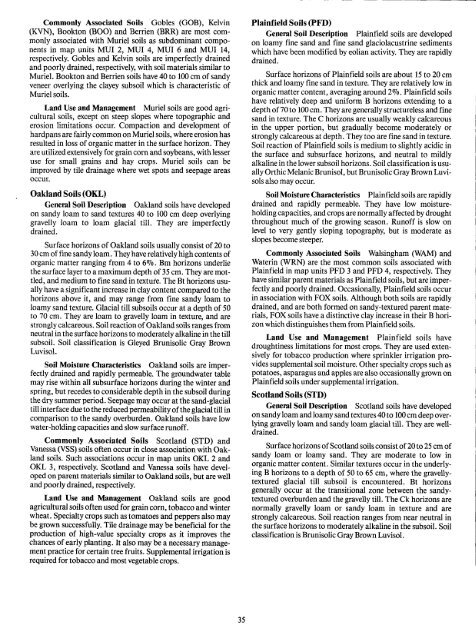The Soils of Brant County - Agriculture and Agri-Food Canada
The Soils of Brant County - Agriculture and Agri-Food Canada
The Soils of Brant County - Agriculture and Agri-Food Canada
- No tags were found...
Create successful ePaper yourself
Turn your PDF publications into a flip-book with our unique Google optimized e-Paper software.
Commonly Associated <strong>Soils</strong> Gobles (GOB), Kelvin(KVN), Bookton (BOO) <strong>and</strong> Berrien (BRR) are most commonlyassociated with Muriel soils as subdominant components in map units MUI 2, MUI 4, MUI 6 <strong>and</strong> MUI 14,respectively. Gobles <strong>and</strong> Kelvin soils are imperfectly drained<strong>and</strong> poorly drained, respectively, with soil materials similar toMuriel . Bookton <strong>and</strong> Berrien soils have 40 to 100 cm <strong>of</strong> s<strong>and</strong>yveneer overlying the clayey subsoil which is characteristic <strong>of</strong>Muriel soils.L<strong>and</strong> Use <strong>and</strong> Management Muriel soils are good agriculturalsoils, except on steep slopes where topographic <strong>and</strong>erosion limitations occur. Compaction <strong>and</strong> development <strong>of</strong>hardpans are fairly common on Muriel soils, where erosion hasresulted in loss <strong>of</strong> organic matter in the surface horizon . <strong>The</strong>yare utilized extensively for grain corn <strong>and</strong> soybeans, with lesseruse for small grains <strong>and</strong> hay crops . Muriel soils can beimproved by tile drainage where wet spots <strong>and</strong> seepage areasoccur.Oakl<strong>and</strong> <strong>Soils</strong> (OWGeneral Soil Description Oakl<strong>and</strong> soils have developedon s<strong>and</strong>y loam to s<strong>and</strong> textures 40 to 100 cm deep overlyinggravelly loam to loam glacial till . <strong>The</strong>y are imperfectlydrained .Surface horizons <strong>of</strong> Oakl<strong>and</strong> soils usually consist <strong>of</strong> 20 to30 cm <strong>of</strong>fine s<strong>and</strong>y loam . <strong>The</strong>y have relativelyhigh contents <strong>of</strong>organic matter ranging from 4 to 6°10 . Bm horizons underliethe surface layer to a maximum depth <strong>of</strong> 35 cm . <strong>The</strong>y are mottled,<strong>and</strong> medium to fine s<strong>and</strong> in texture . <strong>The</strong> Bt horizons usuallyhave a significant increase in clay content compared to thehorizons above it, <strong>and</strong> may range from fine s<strong>and</strong>y loam toloamy s<strong>and</strong> texture . Glacial till subsoils occur at a depth <strong>of</strong> 50to 70 cm . <strong>The</strong>y are loam to gravelly loam in texture, <strong>and</strong> arestrongly calcareous . Soil reaction <strong>of</strong>Oakl<strong>and</strong> soils ranges fromneutral in the surface horizons to moderately alkaline in the tillsubsoil . Soil classification is Gleyed Brunisolic Gray BrownLuvisol .Soil Moisture Characteristics Oakl<strong>and</strong> soils are imperfectlydrained <strong>and</strong> rapidly permeable. <strong>The</strong> groundwater tablemay rise within all subsurface horizons during the winter <strong>and</strong>spring, but recedes to considerable depth in the subsoil duringthe dry summer period . Seepage may occur at the s<strong>and</strong>-glacialtill interface due to the reduced permeability <strong>of</strong>the glacial till incomparison to the s<strong>and</strong>y overburden . Oakl<strong>and</strong> soils have lowwater-holding capacities <strong>and</strong> slow surface run<strong>of</strong>f.Commonly Associated <strong>Soils</strong> Scotl<strong>and</strong> (STD) <strong>and</strong>Vanessa (VSS) soils <strong>of</strong>ten occur in close association with Oakl<strong>and</strong>soils. Such associations occur in map units OKL 2 <strong>and</strong>OKL 3, respectively. Scotl<strong>and</strong> <strong>and</strong> Vanessa soils have developedon parent materials similar to Oakl<strong>and</strong> soils, but are well<strong>and</strong> poorly drained, respectively.L<strong>and</strong> Use <strong>and</strong> Management Oakl<strong>and</strong> soils are goodagricultural soils <strong>of</strong>ten used for graincorn, tobacco <strong>and</strong> winterwheat . Specialty crops such as tomatoes <strong>and</strong> peppers also maybe grown successfully. Tile drainage may be beneficial for theproduction <strong>of</strong> high-value specialty crops as it improves thechances <strong>of</strong> early planting . It also may be a necessary managementpractice for certain tree fruits . Supplemental irrigation isrequired for tobacco <strong>and</strong> most vegetable crops .Plainfield <strong>Soils</strong> (PFD)General Soil Description Plainfield soils are developedon loamy fine s<strong>and</strong> <strong>and</strong> fine s<strong>and</strong> glaciolacustrine sedimentswhich have been modified by eolian activity. <strong>The</strong>y are rapidlydrained .Surface horizons <strong>of</strong> Plainfield soils are about 15 to 20 cmthick <strong>and</strong> loamy fine s<strong>and</strong> in texture . <strong>The</strong>y are relatively low inorganic matter content, averaging around 2% . Plainfield soilshave relatively deep <strong>and</strong> uniform B horizons extending to adepth <strong>of</strong> 70 to 100 cm . <strong>The</strong>y are generally structureless <strong>and</strong> fines<strong>and</strong> in texture . <strong>The</strong> C horizons are usually weakly calcareousin the upper portion, but gradually become moderately orstrongly calcareous at depth . <strong>The</strong>y too are fine s<strong>and</strong> in texture.Soil reaction <strong>of</strong> Plainfield soils is medium to slightly acidic inthe surface <strong>and</strong> subsurface horizons, <strong>and</strong> neutral to mildlyalkaline in the lower subsoil horizons . Soil classification is usuallyOrthicMelanicBrunisol, but Brunisolic Gray Brown Luvisolsalso may occur.Soil Moisture Characteristics Plainfield soils arerapidlydrained <strong>and</strong> rapidly permeable . <strong>The</strong>y have low moistureholdingcapacities, <strong>and</strong> crops are normally affected by droughtthroughout much <strong>of</strong> the growing season . Run<strong>of</strong>f is slow onlevel to very gently sloping topography, but is moderate asslopes become steeper .Commonly Associated <strong>Soils</strong> Walsingham (WAM) <strong>and</strong>Waterin (WRN) are the most common soils associated withPlainfield in map units PFD 3 <strong>and</strong> PFD 4, respectively. <strong>The</strong>yhave similar parent materials as Plainfield soils, but are imperfectly<strong>and</strong> poorly drained . Occasionally, Plainfield soils occurin association with FOX soils . Although both soils are rapidlydrained, <strong>and</strong> are both formed on s<strong>and</strong>y-textured parent materials,FOX soils have a distinctive clay increase in their B horizonwhich distinguishes them from Plainfield soils .L<strong>and</strong> Use <strong>and</strong> Management Plainfield soils havedroughtiness limitations for most crops. <strong>The</strong>y are used extensivelyfor tobacco production where sprinkler irrigation provides supplemental soil moisture. Other specialtycrops such aspotatoes, asparagus <strong>and</strong> apples are also occasionally grown onPlainfield soils under supplemental irrigation .Scotl<strong>and</strong> <strong>Soils</strong> (STD)General Soil Description Scotl<strong>and</strong> soils have developedon s<strong>and</strong>y loam <strong>and</strong>loamy s<strong>and</strong> textures 40to 100 cm deep overlyinggravelly loam <strong>and</strong> s<strong>and</strong>y loam glacial till . <strong>The</strong>y are welldrained.Surface horizons <strong>of</strong> Scotl<strong>and</strong> soilsconsist <strong>of</strong> 20 to 25 cm <strong>of</strong>s<strong>and</strong>y loam or loamy s<strong>and</strong> . <strong>The</strong>y are moderate to low inorganic matter content . Similar textures occur in the underlying B horizons to a depth <strong>of</strong> 50 to 65 cm, where the gravellytexturedglacial till subsoil is encountered . Bt horizonsgenerally occur at the transitional zone between the s<strong>and</strong>ytexturedoverburden <strong>and</strong> the gravelly till . <strong>The</strong> Ck horizons arenormally gravelly loam or s<strong>and</strong>y loam in texture <strong>and</strong> arestrongly calcareous . Soil reaction ranges from near neutral inthe surface horizons to moderately alkaline in the subsoil . Soilclassification is Brunisolic Gray Brown Luvisol .
















